Verb Forms are the different ways in which a verb can be used to communicate different meanings or tenses. Moreover, each verb form has a specific purpose when it comes to sentence construction, thereby helping speakers and writers to communicate time, aspect, mood, and other expressions. English verbs have five forms, which are v1, v2, v3, v4 and v5 that have an important part in grammatical structures. Read on to learn more about each verb form and its meanings, with examples and a list of 50 verb forms.
This Blog Includes:
What is Verb Form V1? Meaning and Example
Verb Form V1, also known as the base form or infinitive, is the simplest form of a verb without any tense or modifications. Interestingly, it is the version of the verb that you read in the dictionary and is used as a starting point for creating other verb forms. In English, the base form is used for many purposes, such as making general statements and forming the present simple tense (except for the third person singular).
Example:
- Base Form: “to eat”
- Sentence: “I eat breakfast every morning.”
In this example, “eat” is the base form of the verb and is used to describe a habitual action in the present.
What is Verb Form V2? Meaning and Example
Verb Form V2, also known as the past tense form, is used to express actions or states that have happened in the past. Furthermore, it shows that the verb’s action has been completed. The V2 form is formed by adding “-ed” to regular verbs, while irregular verbs have unique past tense forms that could be memorised.
Example:
- Past Simple Form: “ate”
- Sentence: “Yesterday, I ate lunch at a new restaurant.”
Here, “ate” is the past simple form of the verb “eat,” showing that the action of eating lunch was completed yesterday.
What is Verb Form V3? Meaning and Example
Verb Form v3, also known as the past participle form, is used in conjunction with auxiliary verbs (have/has/had + v3) and passive voice sentences. Moreover, it expresses an action or situation that has been completed or is in a state of completion. The V3 form is formed by adding “-ed” to regular verbs, while irregular verbs have unique past participle forms.
Example:
- Past Participle Form: “eaten”
- Sentence (Perfect Tense): “I have eaten lunch already.”
In this sentence, “eaten” is the past participle form of “eat,” used with “have” to show that the action of eating lunch was completed before the present time.
Also Read: Verb Cheat Sheet
What is Verb Form V4? Meaning and Example
Verb Form V4, also known as the present participle form or gerunds or the -ing form, is used to form progressive tenses (is/am/are + V4) and as an adjective. Additionally, it communicates an ongoing action or a situation in progress. The V4 form is formed by adding “-ing” to the base form of the verb.
Example:
- Present Participle Form: “eating”
- Sentence (Continuous Tense): “I am eating lunch right now.”
In this case, “eating” is the present participle form of “eat,” used with “am” to describe an action currently in progress.
What is Verb Form V5? Meaning and Example
Verb Form V5, also known as the third-person singular present simple form, is used to communicate actions or situations that are habitual, universal truths, or occur in the present. Additionally, it is used with third-person singular subjects (he, she, it) in the present tense. The V5 form is formed by adding “-s” or “-es” to the base form of the verb.
Example:
- Third-person singular present simple form: “walks”
- Sentence: She walks to work every day.
List of 50 Verb Forms: V1 V2 V3 V4 V5
Here is a list of 50 Verb Forms of V1, V2, V3, V4, V5 for your understanding. Understand and practice these verb forms to improve your
| List of 50 Verb Forms | ||||
| v1 | v2 | v3 | v4 | v5 |
| have | had | had | having | has |
| be | was/were | been | being | is/are |
| do | did | done | doing | does |
| go | went | gone | going | goes |
| say | said | said | saying | says |
| get | got | got/gotten | getting | gets |
| know | knew | known | knowing | knows |
| make | made | made | making | makes |
| think | thought | thought | thinking | thinks |
| see | saw | seen | seeing | sees |
| take | took | taken | taking | takes |
| come | came | come | coming | comes |
| look | looked | looked | looking | looks |
| want | wanted | wanted | wanting | wants |
| use | used | used | using | uses |
| give | gave | given | giving | gives |
| find | found | found | finding | finds |
| tell | told | told | telling | tells |
| call | called | called | calling | calls |
| work | worked | worked | working | works |
| try | tried | tried | trying | tries |
| need | needed | needed | needing | needs |
| ask | asked | asked | asking | asks |
| feel | felt | felt | feeling | feels |
| become | became | become | becoming | becomes |
| put | put | put | putting | puts |
| leave | left | left | leaving | leaves |
| mean | meant | meant | meaning | means |
| let | let | let | letting | lets |
| keep | kept | kept | keeping | keeps |
| seem | seemed | seemed | seeming | seems |
| talk | talked | talked | talking | talks |
| help | helped | helped | helping | helps |
| turn | turned | turned | turning | turns |
| show | showed | shown | showing | shows |
| write | wrote | written | writing | writes |
| sit | sat | sat | sitting | sits |
| believe | believed | believed | believing | believes |
| arise | arose | arisen | arising | arises |
| bear | bore | borne | bearing | bears |
| break | borke | broken | breaking | breaks |
| choose | chose | chosen | choosing | chooses |
| deal | dealt | dealt | dealing | deals |
| deny | denied | denied | denying | denies |
| forsake | forsook | forsaken | forsaking | forsakes |
| hit | hit | hit | hitting | hits |
| weave | wove | woven | weaving | weaves |
| undo | undid | undone | undoing | undoes |
| tear | tore | torn | tearing | tears |
| spin | spun/span | spun | spinning | spins |
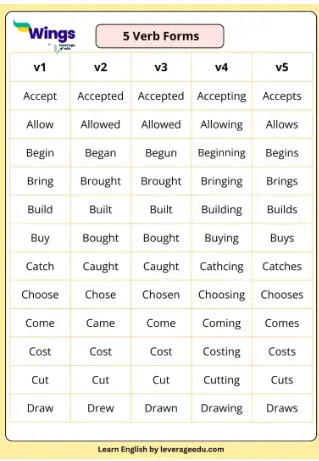
Also Read: Verb Exercise with Answers (Download Free PDF)
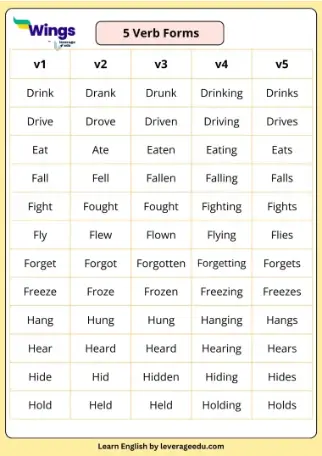
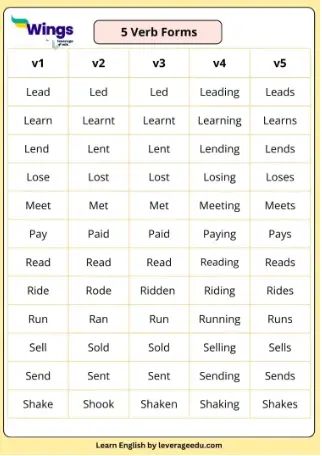
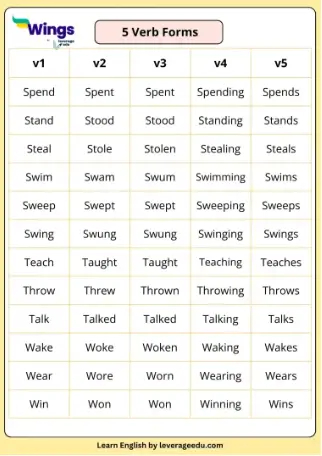
FAQs
V1, V2, V3, V4, and V5 are the five verb forms in English grammar. V1 is the base form, V2 the past tense, V3 the past participle, V4 the -ing form, and V5 the “s/es” form used with singular subjects.
The verb forms of play are as follows:
* V1- play;
* V2 and V3 – played;
* V4 is playing and V5 – plays.
Consider the tense of the sentence (past, present, future).
Determine whether the verb is regular or irregular.
Use the appropriate form based on the tense and the verb’s conjugation.
V2 is used to describe actions that happened in the past.
V3 is used to form perfect tenses and passive voice.
Practice using verb forms in sentences.
Learn lists of common irregular verbs.
Read extensively to expose yourself to different verb forms in context.
Read more blogs on proverbs, idioms and synonyms!
This was all about Verb Forms V1 V2 V3 V4 V5. Hope you understood the concept along with the examples. You can also follow Leverage Edu for more exciting and informative blogs on Learn English.
 One app for all your study abroad needs
One app for all your study abroad needs














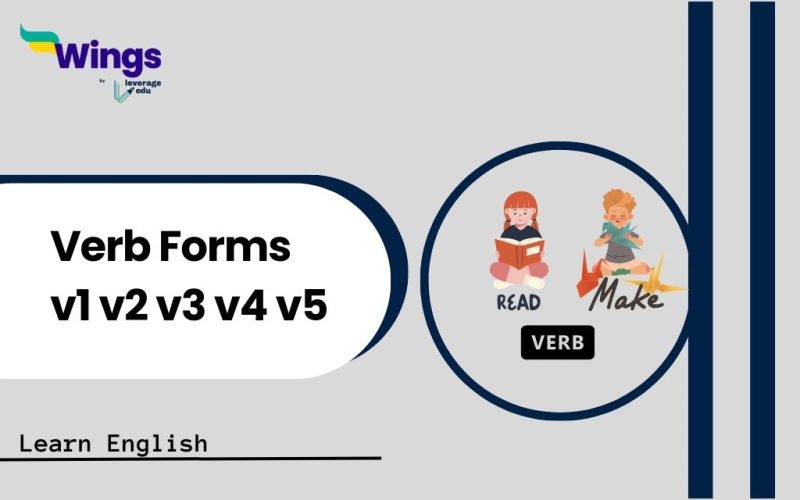
 60,000+ students trusted us with their dreams. Take the first step today!
60,000+ students trusted us with their dreams. Take the first step today!

